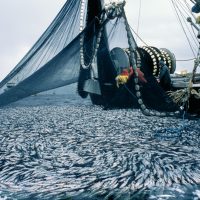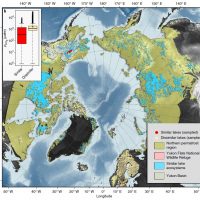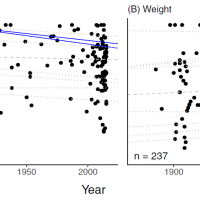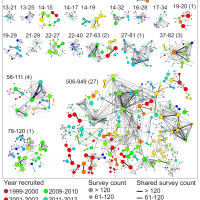Filter Results
The Ocean Modeling Forum presents Pacific herring research in Haida Gwaii, British Columbia
The Ocean Modeling Forum (OMF) is a University of Washington program run through the School of Aquatic and Fishery Sciences that aims to bring together interdisciplinary scientists, modeling experts, decision makers, and other people invested in ocean resources. The OMF helps managers frame questions, understand the strengths and limitations of different models, and learn how to incorporate models in their work.
Read moreTesting the impact of dam passage on homing success in salmon
Snake River salmonids are federally protected, but face a succession of dams to navigate from the ocean to the spawning grounds. The final dam in the sequence is the Lower Granite Dam. Ascending salmonids (sockeye salmon, steelhead, and Chinook salmon) all enter the fish ladders on the side of the dam, but some pass straight through and exit above the dam, while others are shunted off to one side and either released after a longer pathway, or held in tanks and sampled before being released to continue up the fish ladders.
Read moreArctic lakes play a smaller role in releasing ancient carbon than previously thought
The dry northern reaches of Earth contain nearly half of all of the carbon originating in living matter, mostly stored in the frozen soils of the permafrost. It has been long thought that warming in the Arctic will result in this carbon being released from the soil and activated again, through the many lakes that are prominent features of the Arctic.
Read moreWisdom of Crowds: A Conversation with Andrew Berdahl
In 1906 while attending a livestock fair in Plymouth England, Sir Francis Galton witnessed an interesting contest where locals were trying to guess the correct weight of a slaughtered and dressed ox (think jellybeans in a jar, but for butchers). He examined all 800 guesses and calculated the median calling it the vox populi, or “voice of the people,” reasoning that this would cancel out outliers on either side of the true answer. Astonishingly, the median guess was extremely close–within .8%–of the weight measured by the judges and closer than any individual guess. “This started the idea of the wisdom of crowds, where if you have a whole bunch of independent guesses you can average them, cast off the errant guess on either side and hone in on the right answer,” said Dr. Andrew Berdahl one of the University of Washington School of Aquatic and Fishery Sciences’ newest faculty members.
Read moreShifting newspaper headlines on what makes for a ginormous fish
Shifting baselines is the concept that each human generation thinks “normal” conditions are those when they were growing up, and therefore only takes into account declines during their lifetime, instead of over multiple generations. A new paper now examines newspaper headlines over time to see whether declining fish size is detectable in fish described as superlatively enormous (e.g. “giant”, “huge”, or “monster”), finding declines in reports of lengths.
Read moreHelping bird science while walking along the beach: lessons from 17 years of the COASST project
Citizen science, where the nonexpert public joins in freely to produce useful science, has grown to more than 2100 projects on the SciStarter website alone. These projects range from online identification of astronomical objects, to gaming-like projects predicting how proteins will fold (Foldit), to seasonal bird counts. One long-running project is COASST (Coastal Observation and Seabird Survey Team) where members of the public conduct monthly surveys of beach areas from California to Alaska looking for bird carcasses.
Read moreVariability in body growth is an important part of variability in fish populations
It has long been established, indeed it is almost axiomatic, that annual variability in births of new fish (“recruitment”) is the most important reason why the total mass of fish populations varies from year to year. The rate of which individual fish grow (“body growth”) is also known to vary from year to year, but is generally considered to be fairly unimportant in explaining population variability.
Read moreA new guide on how to figure out which parts of DNA are actually expressed
Scientists trained in ecology and physiology are increasingly able to complement their work with the burgeoning field of “functional genomics”, i.e. the study of which parts of DNA (the “genome”) are actually expressed and used to make proteins under different conditions. A new guide is now provided for those from non-genetic fields to harness the power of fast computers and rapid technology in sequencing the letters in DNA, so that they can infer how animals respond to the environment.
Read moreThe blue-backed basslet, a new species from the Honduras
Reef fish species from waters deeper than 130 m are difficult to collect manually, because they are too deep for SCUBA divers. But now manned submersibles equipped with underwater vacuums are able to suck up new specimens with surprising alacrity. Among the specimens slurped up by one such submersible is brand new blue and gold species of basslet: the blue-backed basslet (Lipogramma adabeli), with distinct blue coloration, genetics, and habitat use distinguishing it from other similar species.
Read moreDesigning salmon-friendly dam turbines
The Columbia River used to host returns of nearly 9 million salmon every year, led by the largest returns in the world of Chinook salmon (4.4 million fish). But construction of multiple large dams on various tributaries and the Columbia River itself, eliminated salmon from vast tracts of rivers above impassable dams, and also had a serious effect on salmon survival in the remaining areas.
Read more




